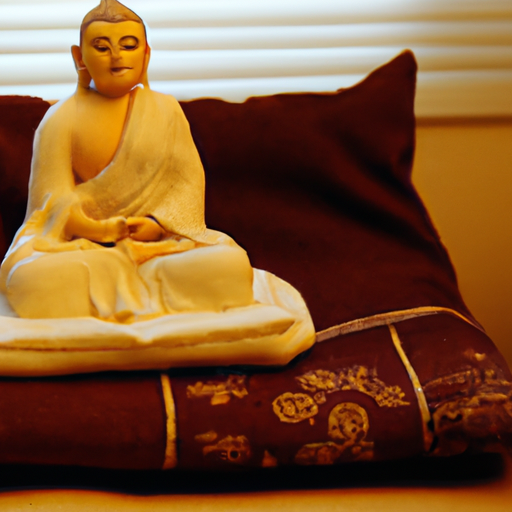Imagine a peaceful oasis where your mind can wander freely, untethered by the limitations of your physical body. In this serene sanctuary, guided meditation offers solace and tranquility, guiding you on a transformative journey of self-discovery. But the question arises: can individuals with physical limitations or disabilities embark on this profound practice? Delve into the depths of this exploration as we uncover the possibilities that lie within, and discover how guided meditation can embrace and empower all souls, regardless of physical constraints.
Understanding Guided Meditation
What is guided meditation?
Guided meditation is a form of meditation where an instructor or a recorded voice guides you through the meditation practice. It is a popular technique for beginners and experienced meditators alike, as it provides a structured approach to meditation and helps you stay focused. The guided instructions usually include breathing exercises, visualization techniques, and body awareness exercises.
Benefits of guided meditation
Guided meditation offers a wide range of benefits for both the mind and body. It can help reduce stress and anxiety, improve sleep quality, enhance concentration and focus, and promote overall well-being. By following the guidance of a meditation instructor, you can deepen your meditation practice and experience a sense of inner calm and relaxation.
Physical Limitations and Disabilities: An Overview
Different types of physical limitations
Physical limitations can vary greatly from person to person. Some individuals may have difficulty with mobility due to an injury, chronic pain, or a physical impairment. Others may have limited strength or range of motion in certain body parts. It is important to recognize that physical limitations can be temporary or permanent, and they can affect individuals of all ages.
Different types of disabilities
Disabilities can be categorized into different types, including physical, cognitive, and sensory disabilities. Physical disabilities refer to conditions that affect a person’s physical abilities or movements. Cognitive disabilities are related to intellectual or developmental impairments that affect a person’s thinking, learning, and problem-solving abilities. Sensory disabilities involve impairments in hearing, vision, or other sensory functions.
Adjustments for Different Physical Limitations
Mobility challenges
For individuals with mobility challenges, adjustments may be necessary to make guided meditation more accessible. This can involve providing options for seated or lying-down positions during meditation to accommodate individuals who cannot sit cross-legged or maintain a specific posture. The use of supportive cushions or chairs can also help individuals with limited mobility find a comfortable position.
Visual impairments
Individuals with visual impairments may benefit from modifications in guided meditation practices. This can include the use of verbal descriptions of visualizations or providing audio recordings with detailed auditory instructions. It is essential to create a safe and obstacle-free meditation space for individuals with visual impairments to ensure their physical safety and comfort.
Hearing impairments
Individuals with hearing impairments can still engage in guided meditation by relying on other sensory cues. Instructors can use visual aids, such as hand gestures or written instructions, to supplement the auditory guidance. Closed captions or transcripts can also be provided for individuals who use sign language or prefer written text.
Adapting Guided Meditation for Individuals with Disabilities
Considerations for physical disabilities
When adapting guided meditation for individuals with physical disabilities, it is important to take into account their specific needs and abilities. This may involve modifying the duration and intensity of the practice, as well as providing alternative movements or poses to accommodate physical limitations. It is crucial to prioritize safety, comfort, and individual autonomy throughout the meditation experience.
Considerations for cognitive disabilities
Individuals with cognitive disabilities may require adjustments to the language and complexity of guided meditation instructions. It is essential to use clear and concise language, and to provide repetition and reinforcement of key concepts. Visual aids or tactile objects can be used to enhance understanding and engagement. Flexibility and patience are key when working with individuals with cognitive disabilities, as everyone learns and processes information differently.
Considerations for sensory disabilities
Sensory disabilities can present unique challenges when practicing guided meditation. Individuals with sensory disabilities may experience difficulty in focusing or maintaining attention during meditation. Creating a calming and sensory-friendly environment can help individuals with sensory disabilities feel more relaxed and centered. This can include using soft lighting, comforting textures, and ambient sounds to enhance the meditation experience.
Assistive Technologies for Guided Meditation
Accessibility features in meditation apps
Meditation apps are increasingly incorporating accessibility features to make guided meditation more inclusive. These features can include options for adjusting font sizes and colors, audio settings for individuals with hearing impairments, and compatibility with screen readers for individuals with visual impairments. By utilizing these accessibility features, individuals with disabilities can fully participate in guided meditation practices.
Adaptive equipment for meditation
Adaptive equipment can enhance the accessibility of guided meditation for individuals with physical limitations or disabilities. This can include supportive cushions or chairs, adjustable meditation benches, and yoga props to provide stability and comfort. Additionally, specialized touch-based or sensory equipment, such as tactile mats or weighted blankets, can help individuals with sensory disabilities engage more fully in the meditation experience.
Guidelines for Instructors and Practitioners
Providing inclusive instructions
Instructors and practitioners play a crucial role in making guided meditation accessible to individuals with physical limitations or disabilities. It is important to use inclusive language and provide alternative options during meditation instructions. Encouraging self-modification, allowing for breaks, and offering variations to accommodate different abilities can help create an inclusive and empowering meditation experience for all participants.
Creating accessible meditation spaces
Creating accessible meditation spaces involves ensuring physical and sensory accessibility. This can include providing ramps or elevators for wheelchair accessibility, adequate lighting for individuals with visual impairments, and quiet or designated spaces for individuals with sensory sensitivities. It is also important to consider the layout and arrangement of the space to ensure ease of movement for individuals with mobility challenges.
Case Studies: Success Stories
Individuals with physical limitations
Several case studies have shown the positive impact of guided meditation on individuals with physical limitations. Through modified poses and adjustments tailored to their specific needs, these individuals have reported improved relaxation, reduced pain, and increased body awareness. Guided meditation has empowered them to focus on their inner self and find peace despite their physical challenges.
Individuals with disabilities
Studies have highlighted the benefits of guided meditation for individuals with disabilities, including improved emotional well-being, enhanced cognitive functioning, and increased self-awareness. By adapting meditation techniques to accommodate different disabilities, individuals have reported decreased stress levels, increased mindfulness, and a greater sense of overall happiness and contentment.
Research and Evidence
Studies on the efficacy of guided meditation for individuals with physical limitations
Numerous studies have examined the efficacy of guided meditation for individuals with physical limitations. These studies have shown positive outcomes, such as improved pain management, increased relaxation, and enhanced quality of life. Guided meditation has been found to be an effective complementary therapy for individuals with conditions such as chronic pain, fibromyalgia, and musculoskeletal disorders.
Studies on the efficacy of guided meditation for individuals with disabilities
Research on the efficacy of guided meditation for individuals with disabilities has demonstrated significant benefits across various domains. Studies have shown positive effects on psychological well-being, reduced anxiety and depression, improved cognitive functioning, and increased self-acceptance and self-esteem. Guided meditation has been found to be a valuable tool for individuals with disabilities in managing stress and enhancing their overall quality of life.
Challenges and Limitations
Limited accessibility in guided meditation resources
Despite the growing popularity of guided meditation, there is still a need for increased accessibility in available resources. Many guided meditation apps, videos, and classes may not offer specific adaptations or options for individuals with physical limitations or disabilities. Lack of representation and limited awareness about the unique needs of individuals with disabilities can make it challenging for them to fully engage in guided meditation practices.
Individual variation in disability and limitation
It is important to recognize that disabilities and physical limitations can vary greatly among individuals. What works for one person may not work for another. Therefore, it is crucial to approach guided meditation with flexibility and openness to customization. By acknowledging individual variations and providing options for adaptation, guided meditation can become a more inclusive and empowering practice for individuals with diverse abilities.
Importance of Inclusion and Accessibility
Promoting equality in meditation practices
Inclusion and accessibility in guided meditation practices promote equality and ensure that individuals of all abilities can benefit from the practice. By creating inclusive spaces and providing adaptive techniques, meditation becomes more accessible to individuals with physical limitations or disabilities. This fosters a sense of belonging and reinforces the principle that everyone deserves the opportunity to experience the transformative power of meditation.
The benefits of inclusive meditation
Inclusive meditation practices have the potential to improve the overall well-being and quality of life for individuals with physical limitations or disabilities. By adapting guided meditation to meet their specific needs, individuals can experience the physical, mental, and emotional benefits of meditation. Inclusive meditation practices empower individuals to connect with their inner selves, find peace amidst challenges, and cultivate a sense of self-acceptance and contentment.
Hi, I’m the Editor of Daily Guided Meditation. Meditation is not just a practice for me, but a way of life. I believe in the power of mindfulness to bring peace and balance into our busy lives. That’s why I created this website, where you can find daily guided meditations to help you on your journey of self-discovery and inner peace. Join our community and experience the transformative benefits of mindfulness through soothing meditations, relaxation techniques, and valuable resources. Prioritize self-care and start your day with intention by exploring our website today. Together, let’s find serenity amidst the chaos.


